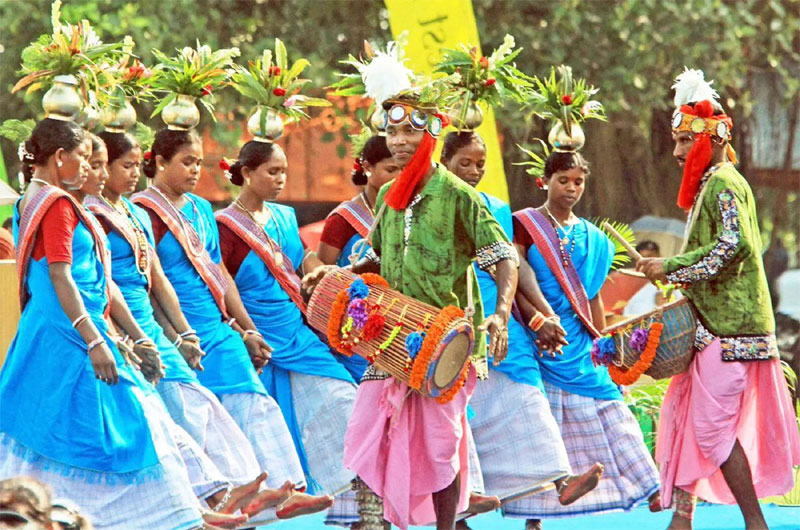
Festivals of Jharkhand: A Vibrant Tapestry of Culture and Tradition
Jharkhand’s festivals reflect the rich cultural heritage and deep-rooted traditions of its diverse tribal communities. Each festival, with its unique customs and celebrations, showcases the vibrant tapestry of life in this dynamic state.
1. Sarhul
Time of Festival
- Celebrated in the spring, typically in the month of March or April.
Specialty of the Festival
- Marks the beginning of the new year for the tribal communities.
- Worship of the Sal tree (sacred tree) and the earth.
- Rituals involve dancing, singing, and offerings to deities.
Locality of the Festival
- Predominantly celebrated by the Oraon, Munda, and Ho tribes across Jharkhand.
Nature of the Festival
- Cultural and religious.
- Involves community gatherings and traditional performances.
- Emphasis on nature worship and gratitude.
2. Karma
Time of Festival
- Celebrated during the monsoon season, typically in the month of August or September.
Specialty of the Festival
- Dedicated to the worship of the Karam tree, symbolizing fertility and prosperity.
- Rituals include fasting, dancing, and the planting of Karam branches.
Locality of the Festival
- Widely celebrated by various tribal communities across the state.
Nature of the Festival
- Religious and agricultural.
- Focus on community bonding and agricultural prosperity.
- Features vibrant folk dances and music.
3. Tusu Parab
Time of Festival
- Celebrated during the harvest season, around January.
Specialty of the Festival
- Involves the creation of Tusu idols and elaborate decorations.
- Singing of traditional Tusu songs.
- Symbolizes the end of the harvest season.
Locality of the Festival
- Particularly popular in the Chota Nagpur Plateau region.
Nature of the Festival
- Agricultural and cultural.
- Celebrates the hard work of farmers and the bounty of the harvest.
- Features communal feasts and traditional folk performances.
4. Makar Sankranti
Time of Festival
- Celebrated on January 14th each year.
Specialty of the Festival
- Marks the transition of the sun into the zodiac sign of Capricorn (Makar).
- Involves kite flying, bonfires, and traditional sweets like tilkut and pitha.
Locality of the Festival
- Celebrated across Jharkhand with regional variations.
Nature of the Festival
- Cultural and religious.
- Emphasis on renewal and new beginnings.
- Activities include community gatherings and feasts.
5. Sohrai
Time of Festival
- Celebrated during the harvest season, particularly in November.
Specialty of the Festival
- Dedicated to cattle, essential to agricultural activities.
- Houses are decorated with traditional Sohrai paintings.
- Includes rituals, dances, and songs celebrating cattle and agriculture.
Locality of the Festival
- Predominantly in rural areas among the Santhal, Oraon, and Munda tribes.
Nature of the Festival
- Agricultural and cultural.
- Focus on the symbiotic relationship between humans and their cattle.
- Features colorful art, community dances, and feasts.
6. Fagua
Time of Festival
- Celebrated during the spring, coinciding with the festival of Holi in March.
Specialty of the Festival
- Known for the vibrant play of colors.
- Includes traditional dances, songs, and the burning of the Holika effigy.
Locality of the Festival
- Celebrated across the state, especially in tribal and rural areas.
Nature of the Festival
- Cultural and religious.
- Emphasis on joy, renewal, and community harmony.
- Features exuberant celebrations with colors, music, and dances.
7. Jani Shikar
Time of Festival
- Celebrated once every 12 years.
Specialty of the Festival
- A hunting festival involving traditional weapons and rituals.
- Participants dress in traditional attire and perform ceremonial hunts.
Locality of the Festival
- Primarily observed by the Santhal tribe in certain regions of Jharkhand.
Nature of the Festival
- Cultural and traditional.
- Emphasis on ancient customs and tribal identity.
- Features ceremonial hunts, traditional music, and dances.
8. Bandna
Time of Festival
- Celebrated in the month of October or November.
Specialty of the Festival
- Involves the worship of cattle, vital for agriculture.
- Houses and cattle sheds are decorated, and cattle are adorned with ornaments.
Locality of the Festival
- Predominantly in rural and tribal areas of Jharkhand.
Nature of the Festival
- Agricultural and cultural.
- Focus on the well-being of cattle and agricultural prosperity.
- Features traditional songs, dances, and communal activities.
9. Bhagta Parab
Time of Festival
- Celebrated in the month of March.
Specialty of the Festival
- Known for extreme physical feats and endurance activities.
- Includes rituals like piercing the body and walking on fire.
Locality of the Festival
- Celebrated by the Oraon and Munda tribes in various regions.
Nature of the Festival
- Religious and cultural.
- Emphasis on devotion and spiritual strength.
- Features dramatic and intense rituals showcasing faith and endurance.
